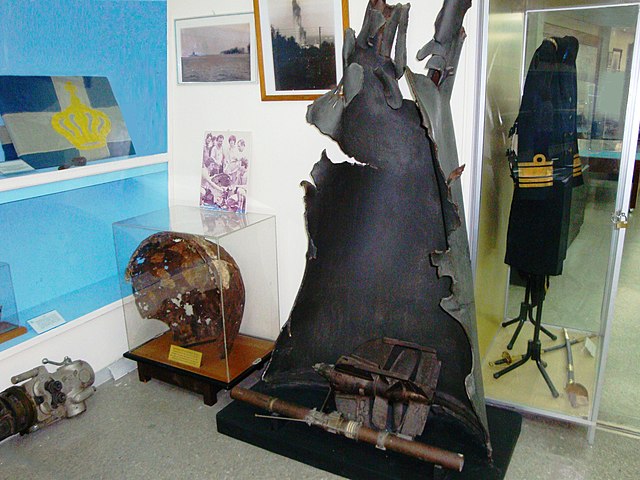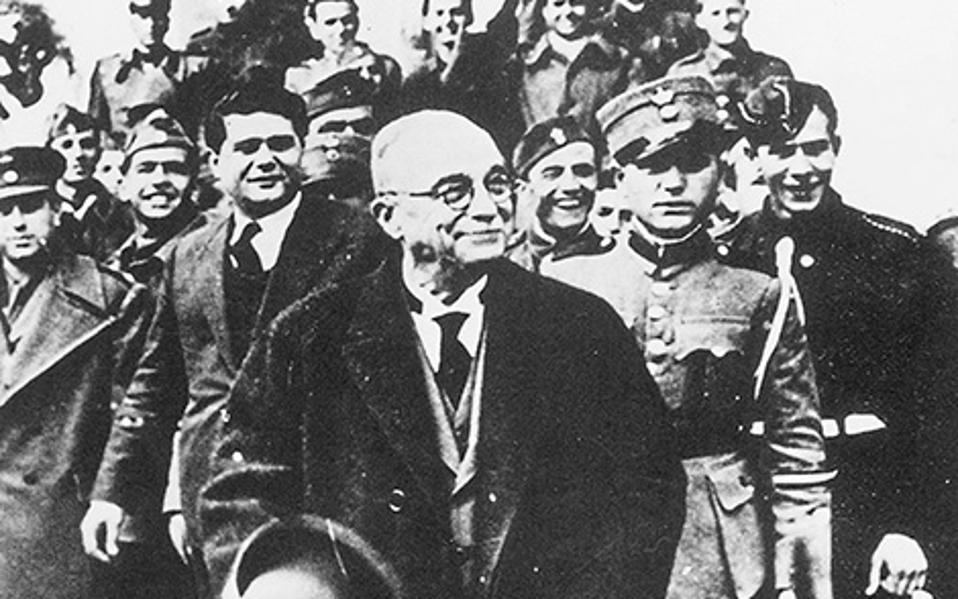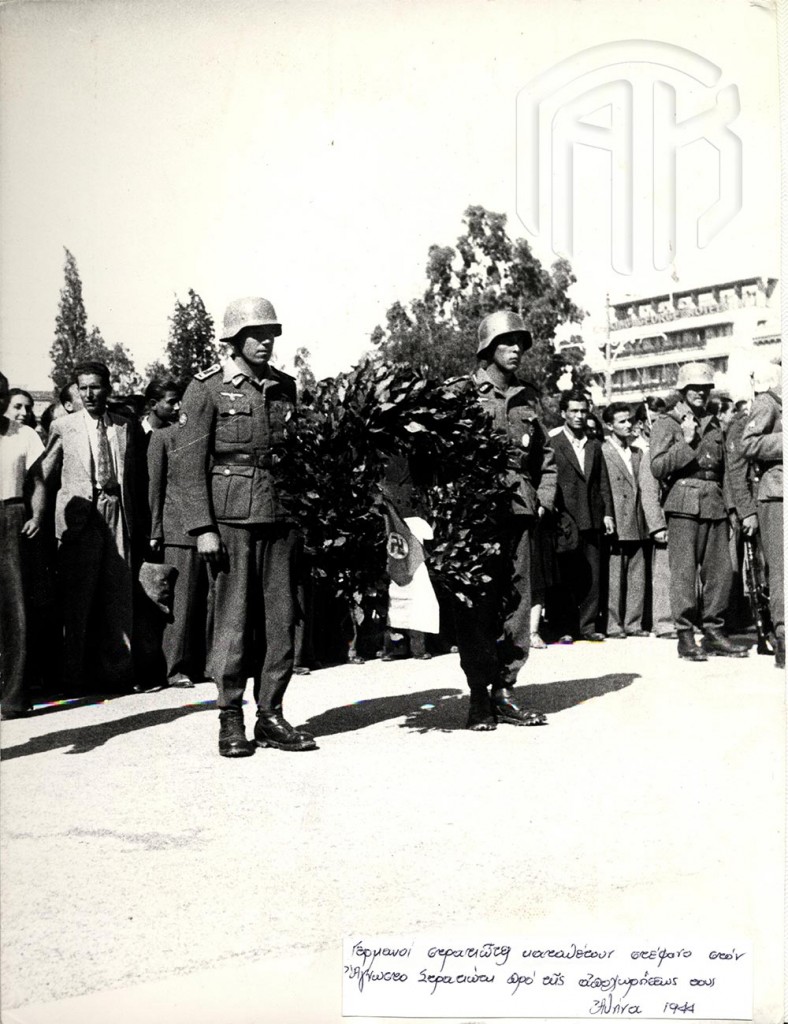Hey! Thats not until 1941. Spoiler warning please!

(because tone cannot be deciphered over text, this is a joke btw)
Hey! Thats not until 1941. Spoiler warning please!

(because tone cannot be deciphered over text, this is a joke btw)
Interview of German historian Karl Heinz Roth in the Bremen based newspaper “Weser Kurier”, about the ongoing debate of WW2 German reparations to Greece (in German)
August 15, 1940: The sinking of cruiser Elli
On August 15, 1940, 8:25 am, the Italian submarine Delfino, sank the Greek cruiser Elli, while she rode at anchor in the island of Tinos. Tinos has the major shrine of Virgin Mary in Greece, and August 15 is the feast day. Elli was transporting pilgrims to the island, and was representing the Navy in the celebrations. The Delfino shot three torpedoes; one of them hit the cruiser’s boiler and she caught fire and sank. Nine petty officers and sailors were killed and 24 were wounded. Delfino attempted, without success, to sink two other civilian transport ships.
The Italian government officials claim ignorance, Ciano in his memoirs wrote that the attack was a result of De Vecchi’s belligerence. In 1972, Italian journalist Mario Cervi revealed that Mussolini was influenced by De Vecchi’s false reports about the presence of English warships in the Aegean (as De Vecchi was the governor of the Italian Islands of the Aegean). Thus, Mussolini instructed the chief of Italian Navy Domenico Cavagnari to choose a reliable submarine commander from the Italian forces of Dodecanese in order to hinder commercial traffic in the Aegean Sea and to sink any ship suspected of smuggling. Cavagnari transmitted Mussolini’s order to the Naval Force Commander of the Dodecanese and, on August 14th, he presented it to De Vecchi. The latter chose Sub-lieutenant Giuseppe Aicardi, who had his submarine in Leros, for the mission. He instructed him to depart immediately for the area between Tinos and Syros. Aicardi, arriving at Tinos’ harbor chose the most important target of anchored warship, in hopes of a promotion.
The Greek investigation found the torpedo that sank Elli and identified it as Italian. Nevertheless, the Greek government chose to keep the fact confidential, and announced that Elli was sank “by an unknown submarine”, as prime-minister/dictator Metaxas did not wish to provoke Italy. Nevertheless, the Italian culpability was obvious to the Greek populace.
From that day on, the entire Greek state machinery started to prepare for war; on August 23 the units stationed on the Greco-Albanian border began their mobilization in full secrecy and the Greek public opinion united against the Italian threat, giving a morale boost to the dictatorial regime which had, for the first time since 1936, the public support.
The moment of the explosion of one of the torpedoes at the jetty of Tinos’ port, on August 15, 1940. The cruiser Elli is on the right side of the pole, seconds before its sinking.

In 1985, Greek divers discovered on the bottom of Tinos port remnants of the Italian torpedo that sank Elli. The torpedo is exhibited at the Maritime Museum of Piraeus.

Congrats, you are doing a great job in covering WW2 in Greece!
I am writing a brief article on why Italy decided to invade war and on how the invasion was doomed to fail already before starting.
The consequences of the Greco-Italian War to the overall Italian war effort, and Mussolini’s prestige are often overlooked
Italy’s Supreme Court this week recognized the right of the Greek victims of a Nazi atrocity to confiscate German property in another European country as compensation.
Based on the ruling, the 296 plaintiffs – survivors and relatives of the victims of the WWII massacre in the village of Distomo in central Greece – are claiming at least 25 million euros, an amount that could be paid out of the revenues of an Italian rail cargo company which is majority owned by German railway operator Deutsche Bahn.
Dr Joachim Lau, the lawyer representing the plaintiffs, told Kathimerini that the main question of whether “we could seize German acquisitions on Italian territory has been answered.”
The victims have been awarded compensation in Greek courts but justice ministers have refused to sign off on the required confiscation order.
On June 10, 1944, a German SS infantry division slaughtered over 200 villagers, most of whom were women, children and elderly residents of Distomo.
Prime minister/dictator of Greece, Ioannis Metaxas, publicly announces the Italian declaration of war, October 28, 1940

Greek Engineer Corps constructing fortifications in Eleas-Kalama sector (Epirus-Greece), March 1939
Albanian front, January-February 1941. Report of an Italian Alpini Battery on Mount Tomori.
Greek mobilization, early November 1940
Greece,November 1940. Ioannis Metaxas is acclaimed after the capture of Korytsa.
Albanian front 1941. Greek soldiers gathered round captured Italian war supplies.
Greek soldier posing with a wrecked Italian L3/33 tankette during the Battle of Elaia-Kalamas, early November 1940.
A Greek officer (the chap with the glasses, second from the left), along with British air-men, at Paramythia air-field, 1940-41
A photo for fun, two Greek soldiers, the left wearing an Italian hat.
Italian Alpinist somewhere in Albania
Straits of Klisoura in 1941. Greek soldiers with a captured Italian tank

Dead and frozen Italian soldier in Mountain Morava. Albania 1940.
Unknown Greek fallen soldier, buried by the Italians
October 12: 75th anniversary of the liberation of Athens from the Nazis
By early October 1944 the Soviet Armies were rapidly advancing to the Balkans, and the British, along with the Greek Armed Forces in the Middle East landed in Peloponnesus and the southern Aegean islands. Most of the country was already under the control of EAM/ELAS, the leftist, pro-communist resistance organization, except Crete (Cretan Resistance), Epirus (under the control of EDES, the nationalist resistance organization) and eastern Macedonia (under Bulgarian occupation). The city of Athens was already a battlefield, with urban forces of EAM fighting the Security Battalions (the collaborationist pro-nazi forces). In reality, only the city’s centre, with most government buildings was under firm german control.
In the night of October 11, 1944, Hellmuth Felmy informed the major of Athens that the city was declared free, that the german forces were leaving the city tomorrow, and that the Security Battalions were to be withdrawn to the main police camp of Athens. In reality, though, clashes will continue during the night, as German forces are destroying major infrastructure to prevent their enemies to pursuit their retreat.
At 08:00 of October 12, General Felmy lay a wreath on the Τomb of Unknown Soldier. At 09:15 the German Guard of Acropolis lowered the Nazi flag.
German soldiers carrying a wreath for the Tomb of the Unknown Soldier

Felmy laying the wreath and giving the nazi salute

The last German leaving Acropolis with the swastika banner
https://www.pronews.gr/sites/default/files/styles/default-inner/public/article/2017/10/12/apel2.jpg?itok=4JiVKSoy
Immediately after this, the jubilant crowd tore apart the nazi wreath and knelt before the Tomb of the Unknown Soldier, as a tribute for the fallen Greeks during the Axis Occupation of Greece (10% of the population perished from 1941 to 1944)

Photos from October 12, 1944
The city remained without any authority until October 18, when the government in exile returned to Greece
Short fim of Filopimin Finos, who was to be the greatest film producer in post-war Greece, shot a small movie depicting the last days of the German occupation and the liberation of Athens, as he was a resistance fighter along with his father, who was executed.
Can you tell more about Metaxas Line and battles to hold on there by Greece defenders ? I know that it was a very tough defensive line and took/absorbed a huge amount of Axis invasion.
Hey man, just a small correction. By October Bulgarian forces had already fallen back to the old borders and were regrouping to join the Third Ukrainian Front. At that time, Thrace and Macedonia were more likely under German occupation.
DId “Island Hopping” tactics in the Pacific influence the tactics in the Aegean during WW2 or vice versa?
I believe the Bulgarian evacuation started on October 10, I’m not sure, though… I’ll check it again tonight
During the German invasion of Greece, all allied forces concentrated their forces in Crete alone, so the rest islands were left to their fate. During the Italian armistice, an attempt was made by the British, Greeks and Italians to transform the Dodecanese islands as an Allied base failed (battle of Leros, inspiration for the movie Guns of Navarone).
In October, with the German retreat, the Germans were fortified in Chania and the island of Melos for anti-aircraft defence, leaving the rest Greece. The allied forces did not attack them, seeing no purpose for unnecessary bloodshed and the Germans surrendered on May 8, 1945.
I suppose, if the Dodecanese campaign was a success, I similar strategy would follow…
The Metaxas Line
The importance of the location that would be the Metaxas Line was first recognized during WW1, when then pro-German government let the Bulgarians and the Germans to enter Macedonia from Fort Rupel (ironically Metaxas, as the chief of staff in 1916, signed the order of surrendering the fort).
During the inter-war years, Bulgaria was considered the major threat against Greece, as she was the only country who aimed the revision of WW1 treaties (mainly, the Treaty of Neuilly), and the raids of IMRO in Greek territory caused a brief war in 1925. It was therefore decided to build further fortifications not only in the area but also along the northern Greek border. By 1935 the planning was complete and in 1936 the construction began, under top secrecy. As Metaxas was, apart from prime minister/dictator, a former general trained in the Engineer Corps, he took part in the design of the line, so it was named after him.
The line was mainly consisted by underground tunnels which included individual terrestrial fortifications, with observatories, positions for artillery and machine guns, along with a tremendous development of anti-tank ditches, with iron and concrete belts on double and triple interlock lines. It was a colossal work, involving the army, universities and industries.
The Commission who took care of the project, under the pressure of time following the work on the selection of fortifications and all other necessary projects, submitted a proposal report to the Ministry of Defense where it was decided after a meeting that the project for the fortification of eastern Macedonia would cover the area from Beles Mountains to Komotini, covering partly a zone of about 300 km, excluding the extensions of anti-tank zones and other additional fortifications that reached the Evros River.
The main purpose of the construction of this fort was not a continuous passive defense, but the repulsion of a sudden attack, and securing the main army’s deployment. The “Fortification Design Committee” that was set up studied the construction only for cover needs which were:
In particular, the Study Committee stated in its report: "It is not excluded (the possibility) that in some areas (of the fortification line), the main forces will uphold the defence (…) The Commission considered that it could not deal with this issue. It is up to the Command to determine what these points will be and whether more or stronger projects should be built there. ". From this cut it is clear that the whole project was only of a temporary defensive nature.
The Metaxas Line was consisted of 21 fortresses.
Each fort was an enclosed work of one or more impermeable complexes, capable of defending in every direction. They included coveralls, artillery positions, machine gun positions, mortar positions, observatories, camouflage works, multiple entrances and exits. The underground facilities of each fort included a command room, officers’ chambers, soldiers’ chambers, a call center, a kitchen, water tanks, sanitary facilities, food stores (for 15 days), a surgeries’ room, a pharmacy, ventilation systems, light systems (generators, oil lamps, flashlights, etc.), drainage, external battle positions, anti-tank barriers, anti-aircraft gun positions, etc.
Fort Rupel Fort is one of the largest. It covers 6.1 of the 155 km of the line and was constructed at a height of 322 m. The fortifications are constructed on three different levels and at some points the thickness of the reinforced concrete reaches 2.5 m.
Opening of new roads: 115 km
Reconstruction and repair of old roads: 92 km.
Excavation of surface works: 16,000 cubic meters
Underground excavations: 291,000 cubic meters
Road excavation: 927,000 cubic meters
Total reinforced concrete 108,000 cubic meters
Total non-reinforced concrete: 68,000 cubic meters
Total length of outer aqueducts: 74 km.
Total length of inland aqueducts: 14 km.
Total length of telephone lines outside the fort: 1,216 km.
Total phone length lines in the forts: about 70 km.
Total wire mesh development length: 90 km.
Total quantity of cement: 66,000 tonnes.
Total quantity of reinforced concrete: 12,000 tonnes.
Total length of underground galleries: 24,000 meters,
Total length of underground shelters - chambers: 13,000 meters,
Total length of water pipes: 88,000 meters,
Total expenditure: 1.5 billion drachmas (equal to 58.5 billion euros (2002)),
Total wages: 3,000,000, (2,900,000)
Duration of construction: 3.5 years, (November 1936 - July 1940). The project was subjected to some cuts, which included one more fort and some other reinforcement works.
These structures were particularly durable, and some are still used today.
The interior of these works was mainly illuminated with oil lamps, while some were also powered by generators (Today the fortresses of this line are lit by the electricity network, but still maintain the generators). Their ventilation was achieved by both artificial and natural methods. The water was supplied by the public network.
All fortresses are kept in good working order. Some are open to the public.
Why Metaxas Line ultimately failed?
Also, photos from the battle here: https://www.roupel.gr/η-μαχη-των-οχυρων/
Private Gregory Angelopoulos
Malimadi, November 5, 1940
Hunger drove me at noon to the regiment’s seat. I found cheese, olives and red wine. I brought them to my tent with the medic and we feast from this exquisite meal. As soon as I had finished I told him that death would now be less painful. Before finishing, an airplane bomb whistled upon me and fell into the forest, 20 meters below my tent. Rocks were falling on my tent and I came out to check. A fellow soldier shouted for his foot and called for help. I tied the wound under bombardment (overwhelming tibia fracture). Another guy, light wound on the skull. Third case, got hit on the lumbar spine. I approached the pit that the bomb created. A body drowned in blood without skulls and brains. Besides him, a corporal from Gargalianoi, named Anagnostopoulos, he was alive […] a hole opened behind, at his spine, and his intestines poured out. He died in my hands! My heart was completely broken from the horror … The soldiers lost their moral! In the evening, Colonel spoke to us in pain, and asked from us to take revenge for our fallen brethrens. The major told us the same and promised that we would plunder and fuck (sic) the Italians. I let my self to fall into a desperate sleep.
Private Stathis Gotsinas
12-12-1940
Devilish snow. Everything is blurry. Fat snowflakes. And snowing became even thicker at dawn, like cotton. I’ve never lived such a thing. And we are at a relatively low altitude. Imagine the hell at the front lines.
I hitched up the carts for the rationing. Approximately 1,5 hour away was the village of Stroko, some 30 houses and a minaret’s obelisk stands out in the middle. I walked the distance. You can’t be in a cart or upon a horse. You lose everything. And it’s not just the cold. You feel a weird pain on your limbs that strikes your head. Socks, gloves can do nothing. There is no salvation. On the narrow road used by carts and cars, endless rows of Soldiers are descending from the front. Unshaven, dirty, muddy, with broken noses and swollen lips. You can see the snots and saliva of the soldiers crystalized on their beards, more disgusting than ever. Their eyes are faded. Their expression demonstrates the trials of cold, absence of sleep, hardship and war agony. They took them to the rear to rest. They are painted white from the snow. Nobody speaks. They remain persevere. They remained upright for days and night, over naked rocks, taking rifle and artillery fire, almost without food. Now they were empty. They are keeping coming, it’s the whole regiment. I mean the survivors. They transported them to the nearest village. In ten days they will be at the front lines again. Perhaps they will have with them our division commander’s pleasure. “To my infrantry” (notice that “my”) “I express my deepest pleasure”. War is a terrifying composition. You lose your mind when you see it face to face and when you feel it.
Back to the supplies, snow and mud. I try to sleep in vain. I found, Chrysoula (his sister), your letter on the office. Office, a completely conventional word. A room of 5 square meters, where 5-6 officers are sleeping on the floor. Our desks are the chairs and the parcels. How extraordinary was your letter, my dear. Two kind words erased days of fatigue from battles and other hardships. Also, I got a parcel from our friend B., with a scarf and currants. Great thing! Not because of the content, but because it came, it reached us. All these letters and parcels acquire a greater status than their real one. Even if it is something trivial. You can’t understand this feeling if you are not at the war. They have their meaning, their boost for our morale. An incurable suffering controls us, and two words bring back our childish character, our soul, they revitalized us. What a mystery…